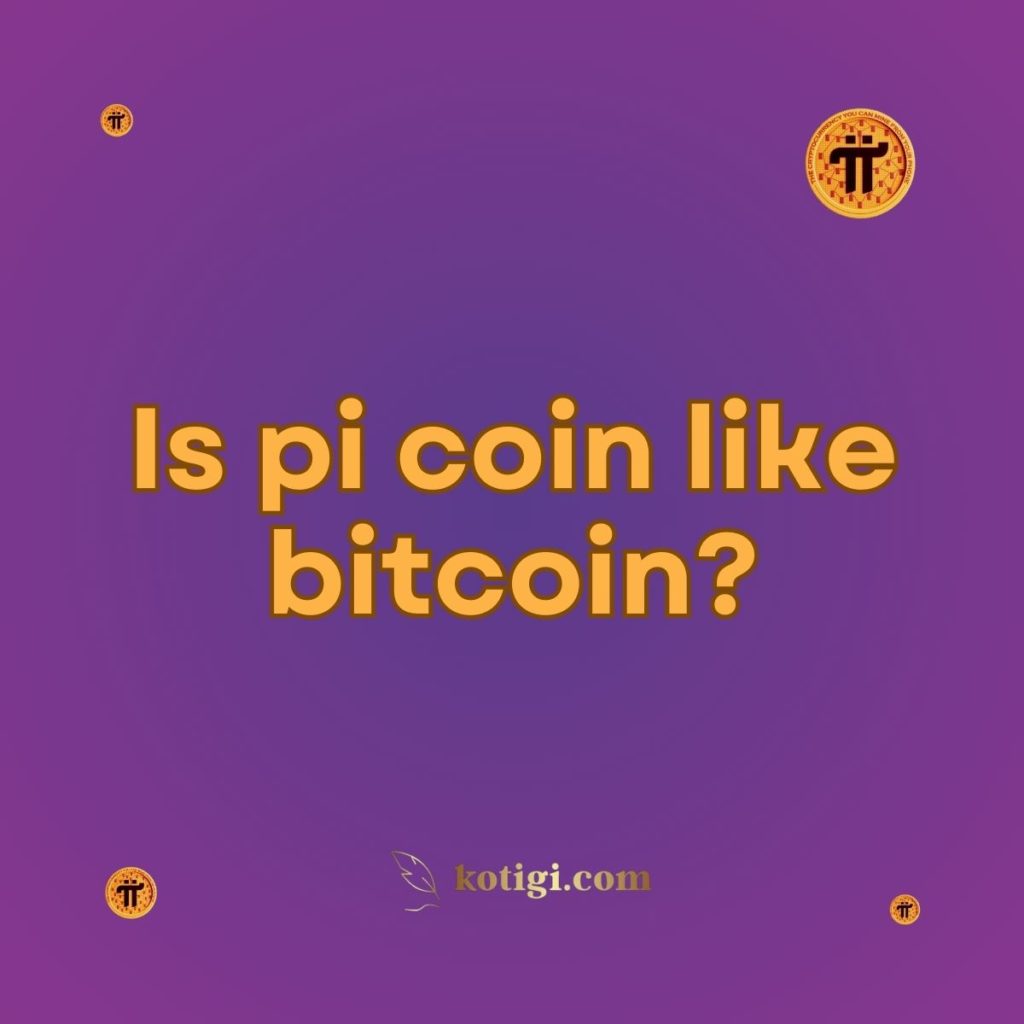
Cryptocurrencies have taken the financial world by storm, with Bitcoin leading the way as the first and most well-known digital currency. However, newer cryptocurrencies like Pi Coin have emerged, with promises of revolutionizing how people mine and use digital currencies. As Pi Network grows in popularity, many users are wondering: Is Pi Coin like Bitcoin? While there are similarities between the two, Pi Coin and Bitcoin differ significantly in their mining processes, blockchain technologies, and future potential.
What Is Pi Coin?
Pi Network Overview
Pi Coin is the native cryptocurrency of the Pi Network, a blockchain project launched in 2019 by a group of Stanford graduates. Pi Network aims to democratize cryptocurrency mining by allowing users to mine Pi coins directly from their smartphones, without the need for expensive hardware or significant energy consumption. The goal of Pi Network is to create a decentralized digital currency that is easily accessible to everyone, regardless of their technical expertise or financial resources.
Unlike Bitcoin, Pi Network is still in its development phase, and the coins mined on the platform are not yet tradable. The project is currently in its Testnet phase, with plans to transition to Mainnet in the near future. Once Mainnet is launched, Pi Coin will become fully functional and tradable.
How Pi Mining Works
Mining Pi is designed to be simple and accessible. Users download the Pi Network app, create an account, and press the “Mine” button once every 24 hours to start a new mining session. The mining process does not require powerful hardware or high energy consumption, making it more eco-friendly than traditional mining methods used by cryptocurrencies like Bitcoin.
What Is Bitcoin?
Bitcoin, launched in 2009 by an anonymous entity known as Satoshi Nakamoto, is the first decentralized digital currency. It was created as a response to the 2008 financial crisis, with the goal of providing a peer-to-peer payment system that operates independently of central banks and financial institutions. Bitcoin uses a public ledger called the blockchain, which records all transactions and ensures the network’s security and transparency.
Bitcoin operates on a Proof-of-Work (PoW) consensus mechanism, where miners use powerful computers to solve complex mathematical puzzles. These puzzles secure the network and validate transactions, and miners are rewarded with new bitcoins for their efforts. However, this process requires significant energy consumption and specialized hardware, making Bitcoin mining both expensive and resource-intensive.
Similarities Between Pi Coin and Bitcoin
Decentralization
One of the key similarities between Pi Coin and Bitcoin is their shared vision of decentralization. Both cryptocurrencies aim to eliminate the need for centralized authorities like banks and governments in financial transactions. Instead, they rely on a network of users to validate transactions and maintain the integrity of the blockchain.
Pi Network, like Bitcoin, aspires to create a decentralized ecosystem where users can make peer-to-peer transactions without intermediaries. Both projects seek to empower individuals by giving them control over their own assets.
Blockchain Technology
Both Pi Coin and Bitcoin are built on blockchain technology. A blockchain is a decentralized ledger that records all transactions across the network. Each transaction is grouped into a block, and these blocks are linked together to form a chain. This structure ensures that the data is secure, transparent, and immutable.
While the underlying blockchain technology is similar, the mechanisms through which Pi Coin and Bitcoin operate are quite different, particularly in terms of mining and consensus protocols.
Cryptographic Security
Both Pi Coin and Bitcoin use cryptographic methods to secure transactions. Cryptography ensures that all transactions are encrypted and that only authorized users can access their funds. This makes both cryptocurrencies secure and resistant to fraud and hacking.
Key Differences Between Pi Coin and Bitcoin
Mining Process
The most significant difference between Pi Coin and Bitcoin lies in their mining processes.
- Bitcoin Mining: Bitcoin mining requires specialized hardware called ASICs (Application-Specific Integrated Circuits) or high-end GPUs (Graphics Processing Units). The mining process involves solving complex mathematical problems, and the miner who solves the problem first is rewarded with newly minted bitcoins. This process is known as Proof-of-Work (PoW) and is energy-intensive, consuming vast amounts of electricity.
- Pi Coin Mining: Pi Coin uses a much simpler and more eco-friendly mining process. Instead of solving complex puzzles, Pi miners only need to open the Pi Network app and tap a button once every 24 hours to continue mining. Pi Network uses a Proof-of-Authority (PoA) or Stellar Consensus Protocol (SCP) to validate transactions, making it far less resource-intensive than Bitcoin’s PoW. Additionally, Pi mining can be done on a mobile phone, whereas Bitcoin mining requires powerful and expensive hardware.
Energy Consumption
One of the major criticisms of Bitcoin is its massive energy consumption. Bitcoin mining consumes as much energy as entire countries, leading to concerns about its environmental impact. According to estimates, Bitcoin mining uses more electricity annually than some small nations, like Argentina or the Netherlands.
In contrast, Pi mining is designed to be energy-efficient. Since the process does not involve solving complex mathematical problems, it does not require significant computational power or electricity. Users can mine Pi coins on their smartphones without draining their battery or using large amounts of energy, making it a much greener alternative to Bitcoin mining.
Market Value
As of now, Bitcoin is the world’s most valuable cryptocurrency, with a market cap of over $500 billion. Its value has grown exponentially since its creation in 2009, and it remains the most widely used cryptocurrency for both investment and transactions.
Pi Coin, on the other hand, is still in its early stages and does not yet have a market value. Pi coins are currently not tradable or exchangeable for fiat currency or other cryptocurrencies. The value of Pi Coin will only be determined once the network transitions to Mainnet, and the coins become available for trading.
Accessibility
Bitcoin mining has become increasingly inaccessible to everyday users due to the high cost of mining equipment and electricity. Only large-scale operations or individuals with significant resources can profitably mine Bitcoin today.
Pi Network, on the other hand, was designed to be accessible to everyone. Mining Pi requires only a smartphone and no financial investment, making it possible for anyone to participate, regardless of their technical expertise or financial resources. This democratization of cryptocurrency mining is one of Pi Network’s primary goals.
The Future of Pi Coin vs. Bitcoin
Bitcoin’s Future
Bitcoin has firmly established itself as the king of cryptocurrencies. Its position as the first and most valuable cryptocurrency has solidified its place in the digital economy. Bitcoin is widely accepted by businesses and institutions, and its use cases continue to expand, from being a store of value to serving as a medium of exchange.
However, Bitcoin faces challenges, particularly in terms of scalability and environmental sustainability. The network can handle only a limited number of transactions per second, which has led to high transaction fees during times of peak demand. Additionally, Bitcoin’s energy consumption continues to be a topic of debate, with some questioning its long-term viability.
Pi Network’s Future
Pi Network has enormous potential, but it is still too early to determine its success. The network is in the process of building a decentralized ecosystem where Pi coins can be used for everyday transactions, both online and offline. Once the network transitions to Mainnet, users will be able to trade their Pi coins on exchanges and use them within the Pi economy.
The success of Pi Network will depend on its ability to attract developers, businesses, and users to build and engage with the platform. If Pi Network can achieve its goals of creating a scalable and decentralized cryptocurrency, it could become a major player in the crypto space.
Conclusion
Is Pi Coin like Bitcoin? In some ways, yes, but there are also significant differences. Both Pi Coin and Bitcoin share a vision of decentralization and use blockchain technology to secure transactions. However, the mining processes, energy consumption, and current market value differ greatly between the two. Pi Coin’s mobile-friendly and energy-efficient mining system sets it apart from Bitcoin’s resource-intensive Proof-of-Work mechanism. While Bitcoin is well-established with significant market value, Pi Coin is still in its early stages, and its future success remains to be seen.
Is pi coin like bitcoin?
While both Pi Coin and Bitcoin are decentralized cryptocurrencies that use blockchain technology, they differ in their mining processes, energy consumption, and market value. Pi Coin can be mined on mobile phones with minimal energy, while Bitcoin requires expensive hardware and consumes significant electricity.
Key Takeaways
- Pi Network’s future success will depend on its transition to Mainnet and the development of a decentralized ecosystem for Pi coin usage.
- Both Pi Coin and Bitcoin are decentralized cryptocurrencies that aim to eliminate the need for intermediaries in financial transactions.
- Pi Coin uses a mobile-friendly mining system, while Bitcoin relies on energy-intensive Proof-of-Work mining.
- Pi mining is free and eco-friendly, whereas Bitcoin mining requires expensive hardware and high energy consumption.
- Bitcoin has a significant market value, while Pi Coin is still in its Testnet phase and not yet tradable.





